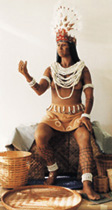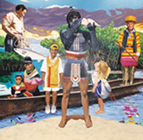

|
Scientist, Artists Collaborate To Showcase Historical And Natural Florida Through New Exhibits
By Cathy Keen
An artist's sketches of early Native Americans trading pearls and precious stones along the banks of the Apalachicola River drew a frown from the Cherokee woman.
"Do you have to have all these people sitting 'Indian style?'" the adviser to the Florida Museum of Natural History project asked pointedly of the cross-legged figures. Her people sat in a variety of positions, she told the curators, cross-legged being just one of them.
"That was a subtle but powerful stereotypical depiction of Native Americans," says Darcie MacMahon, a UF anthropologist and project manager for the Northwest Florida: Waterways and Wildlife exhibit in the museum's new Powell Hall Education and Exhibition Center. "Obviously, we changed our design."
The exchange is typical of many that have occurred during the researching, designing and building of three halls at the new center that will trace Florida's natural and cultural roots from pre-history to the present. The new exhibits, which will cost an estimated $8 million when completed in 2004, succeed immensely popular displays formerly located in Dickinson Hall near the center of the UF campus. Powell Hall is located between the Harn Museum of Art and the Center for the Performing Arts on the west end of campus.
Physical posture was one of many elements debated during the design and construction of the Northwest Florida exhibit. Another issue was cultural: The original design called for representatives of a visiting tribe from what is now northern Georgia to paddle up and for two male chiefs to begin bartering. But after a lively debate, the design team decided to make the leader of the Florida tribe a woman and to turn the scene into an exchange of gifts between nobles.
"In the Southeast, there sometimes were women chiefs, and female leadership is certainly a popular issue today that our audience could probably relate to," says artist Merald Clark.
"Recreating this kind of setting is a challenging process because there is only so much that you know through the science of archaeology and there is a lot of interpretation - many leaps of faith - that you have to make," MacMahon says. "Mostly we've tried to stick with what the native people said about themselves, including how they depicted themselves in their own artwork."
Shell engravings, copper plates and other period art reveal the kind of hairstyles and beads people might have favored. For the life-like mannequins, a sculptor bodycast modern Indians up to their necks, used information from skeletal bones in the museum's collection to reconstruct the faces and then added costumes, tattoos and other finishing touches.
The displays in Powell Hall are the educational manifestation of the archeological and anthropological research being conducted by UF researchers throughout the state, says museum Director Douglas S. Jones.
Guided by archaeologists, natural scientists and educators, each of the exhibits' designs have undergone dramatic changes as artists' black-and-white drawings morphed into designers' miniature three-dimensional models and, ultimately, into the final product.
Archaeological excavations in the mangrove islands of Charlotte Harbor and Pine Island Sound near Fort Myers, for instance, challenge long-held ideas about the native Calusa Indians and form the basis for the South Florida: People and Environments exhibit.
"Before we worked in Southwest Florida we were not really aware that the people had a 6,000-year-old fishing heritage," says Bill Marquardt, a UF anthropologist who has done fieldwork there for 15 years. "We knew there were fishing people at the time Spanish explorers arrived and we had some archaeological sites suggesting they dated back several hundred years, but we had no idea the tradition was thousands of years old."
The large mural gracing the exhibit's entrance went through many transformations in response to comments from archaeologists like Marquardt and Native American consultants.
Artist Bob Beach ultimately came up with a collage that highlights various themes from the exhibit. A fiery sunset amid black storm clouds sets off the deep blue waters of the coastal estuary, while a mullet splashing above the surface underscores the importance of the Calusa's net-fishing tradition. A Calusa man stands alongside the marsh and mudflats, surrounded by a Cuban fisherwoman and Seminole Indians in canoes. A contemporary boy and girl look in as if to reflect upon the scene's overlapping mix of past and present.
The challenge with this type of presentation, says exhibit designer Dorr Dennis, is to sustain a complex story line while alternating between traditional exhibits of artifacts that stimulate the mind and interactive displays that excite the senses.
When the first phase of the exhibit opens next spring, visitors will stroll through mudflats and seagrasses and take an underwater, larger-than-life walk through an estuary. Tiny, often unnoticed elements of an estuary - like barnacles and other sea creatures - will be magnified 10 fold, and strobe lights will create the illusion of fish darting to and fro.
"The design almost starts to take on a life of its own after awhile and you need to know how to balance it," Dennis says. "That's not a science, it's more of an art."
Viewers will see seldom-displayed 1,000-year-old fishing nets, floats and cords that were so much a part of this early Native American lifestyle. The last section of the exhibit also features wooden bowls, masks and various other artifacts of the Calusa - the last native Florida Indian society to succumb to the consequences of the European invasion - while it explores the customs of the Seminole and Miccosukee Indians who succeeded them in South Florida.
"People assume that American Indian traditions are no longer vibrant," MacMahon says. "Yet they've been able to retain many of their cultural traditions against amazing odds, especially the Seminole and Miccosukee, who have been pushed farther and farther south into the Everglades. Their two languages are still actively spoken."
Developing respect for this heritage is one of the aims of the exhibits.
"We're trying to encourage stewardship of the natural and cultural history of the state," MacMahon says. "After you've walked through the exhibit, we'd like you to have an appreciation for the Indian people of South Florida in the past and present and for the fragile environments that make South Florida what it is. And to feel that you have a personal stake in it."
Preservation also is a focus of the Northwest Florida: Waterways and Wildlife exhibit, part of which opened last fall. The exhibit features an area of the Florida Panhandle west of the Ochlockonee River and includes a flood plain, forest, hammock, limestone cave and a bog filled with carnivorous plants.
The region is critical for its biodiversity. The Apalachicola River is one of the most species-rich waterways in the eastern United States, says Dick Franz, a natural historian in charge of the exhibit. There are more species of turtles and mussels in the Apalachicola than any other river in North America, and the Panhandle is the world center for bug-eating pitcher plants, which capture their prey in deadly but beautiful ways, Franz says.
Recreating such an environment requires imagination, skill and patience. For example, museum artisans had to cut out and hand paint more than 5,000 plastic leaves cast from plaster molds of real leaves found in the region.
Molds of limestone in Florida Caverns State Park near Marianna were used to sculpt a crystal-studded cave whose predecessor was a highlight of the Dickinson Hall exhibit.
"The real challenge is that a cave takes thousands of years to form," says artisan Karen Aneiro. "We had a year to build an illusion of a cave."
To create the dripping effect of stalactites, artists poked pencil-shaped Plexiglas rods into the ceiling and then painted the area with epoxy to give it a wet look.
"I put about 450 to 500 of them up, one at a time, so I know each one of them intimately," Aneiro says. "It's a little bit of a zen experience. If you don't have patience, you'll learn it very quickly."
Stacey Breheny's patience also was tested as she worked to blend a nearly 360-degree mural of cypress trees, swamp waters and moss-carpeted hammock with the three-dimensional cave in the foreground.
Breheny used a hydraulic lift to paint treetops on the 25-foot-high mural, feathering them with light, airy strokes to create the illusion of distance between them and the dark, dense plant life at the swamp's base.
"It was definitely a challenge because the artist has to paint treetops from a foot away at eye level, but if you go outside to look at trees you're always standing in a different place," she says, adding "and they look different depending on whether you're standing underneath them or 20 feet back."
Finding such different perspectives at the crossroads of art and science - and making certain they are as accurate and interesting as can be - is the ongoing task of the artists, archaeologists and natural scientists at the museum.
Related web site:
http://www.flmnh.ufl.edu